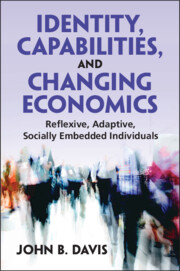Book contents
- Identity, Capabilities, and Changing Economics
- Identity, Capabilities, and Changing Economics
- Copyright page
- Dedication
- Contents
- Tables
- Boxes
- Preface
- Acknowledgments
- Part I The Failed Pathway and Exit Strategies
- Part II Building a Socially Embedded Individual Conception
- 4 Adaptive Reflexive Individuals
- 5 A General Theory of Social Economic Stratification
- 6 Roads Not Taken Yet to Be Taken
- Part III Value and Subjectivity
- References
- Index
4 - Adaptive Reflexive Individuals
A Capability Conception of the Person
from Part II - Building a Socially Embedded Individual Conception
Published online by Cambridge University Press: 11 January 2024
- Identity, Capabilities, and Changing Economics
- Identity, Capabilities, and Changing Economics
- Copyright page
- Dedication
- Contents
- Tables
- Boxes
- Preface
- Acknowledgments
- Part I The Failed Pathway and Exit Strategies
- Part II Building a Socially Embedded Individual Conception
- 4 Adaptive Reflexive Individuals
- 5 A General Theory of Social Economic Stratification
- 6 Roads Not Taken Yet to Be Taken
- Part III Value and Subjectivity
- References
- Index
Summary
Chapter 4 lays out the book’s adaptive, reflexive capability view of socially embedded individuals. An important reason we ought to see people as adaptive is that this provides a basis for explaining how they make choices and act in changing, often highly uncertain environments – large worlds rather than small Bayesian ones. When we accept that choice is context-dependent, we need to be able to explain individuals’ behavior in the most demanding circumstances they can face. An implication of this framing is that, as in Simon’s procedural rationality view, behaviorally speaking there is really no maximization – only continual adjustment over time. To capture all this, I use a stock flow, state description/process description characterization of adaptive individuals, and then model their behavior more specifically as a capability choice/action capability pattern of behavioral adjustment that works via a reflexive feedback loop. Given that this individual conception also needs to satisfy the two identity criteria I used in Part I to evaluate the standard Homo economicus individual conception, I then show how an adaptive, capability individual conception successfully individuates people as distinct and independent. In light of how undemocratic economic and social institutions limit people’s capability development, I also discuss the circumstances under which they can be reidentified as the same individuals over time.
Keywords
- Type
- Chapter
- Information
- Identity, Capabilities, and Changing EconomicsReflexive, Adaptive, Socially Embedded Individuals, pp. 83 - 108Publisher: Cambridge University PressPrint publication year: 2024

